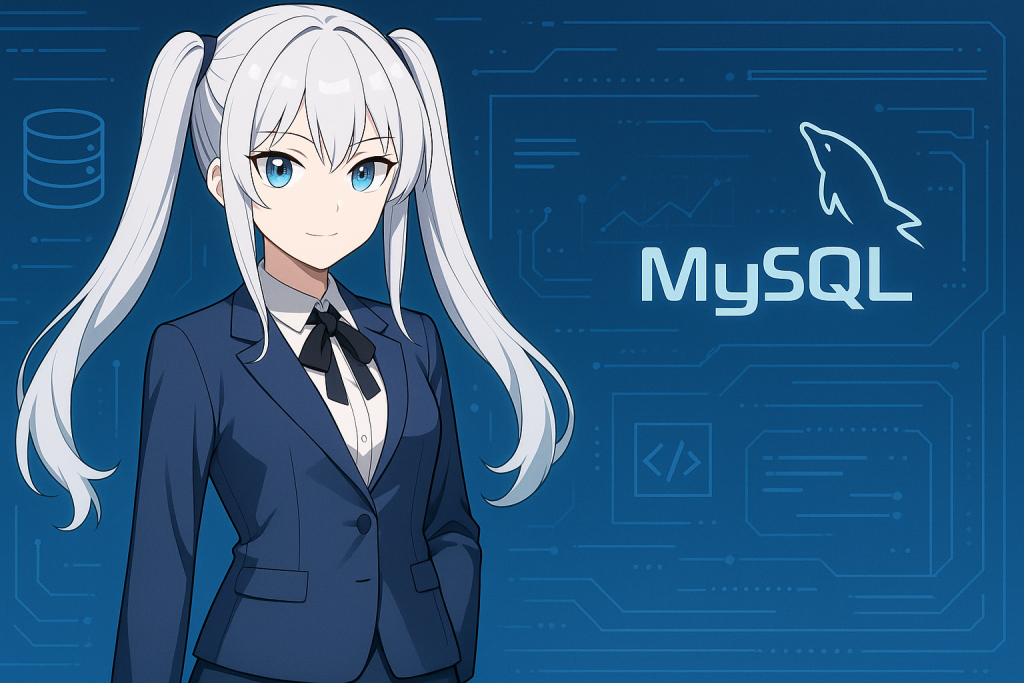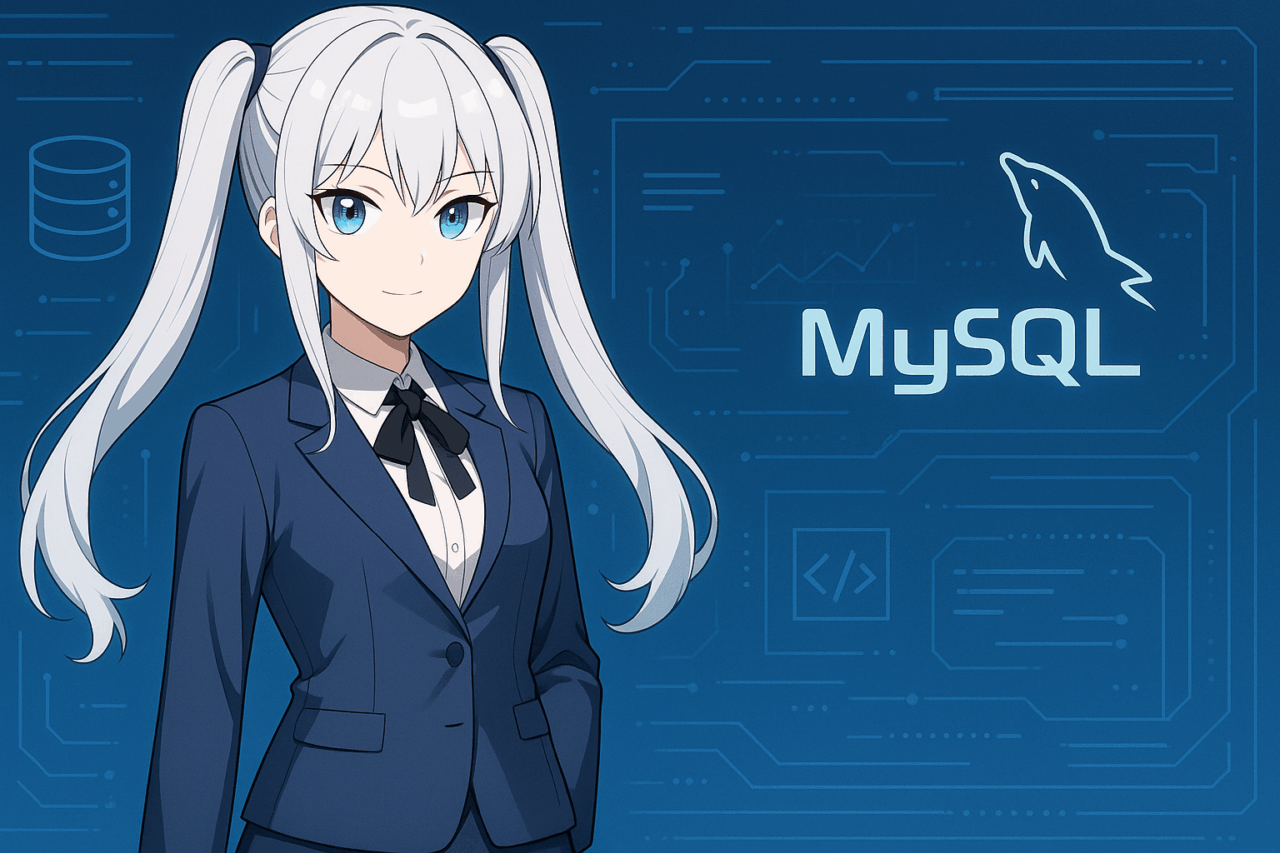- 1 1. Introduction
- 2 2. Overview of the MySQL 9 Series and Release Background
- 3 3. Update History by Version (Summary of 9.0-9.3)
- 4 4. Highlighted New Features and Practical Usage Examples
- 5 5. Comparison of New Features with Other RDBs (PostgreSQL, MariaDB, etc.)
- 6 6. Migration and Introduction Guide to MySQL 9 Series
- 7 7. Summary and Recommended Usage Differentiation
- 8 8. Frequently Asked Questions (FAQ)
- 8.1 Q1. Can MySQL 9.x be used in a production environment?
- 8.2 Q2. Can the vector type replace full-text search?
- 8.3 Q3. Can JavaScript stored procedures be used in the free version (Community Edition)?
- 8.4 Q4. The native_password authentication method has been deprecated, what should I do?
- 8.5 Q5. Compared to other RDBs (such as PostgreSQL or MariaDB), what are the strengths of MySQL 9?
- 8.6 Q6. What are the points prone to issues during upgrades?
- 9 9. Related Links and References
1. Introduction
MySQL is a representative relational database management system used by companies and engineers around the world. Among them, the “MySQL 9” series, which appeared after 2024, stands out from previous versions as an “innovation release,” incorporating numerous new features and cutting-edge technologies that further expand the possibilities of databases.
Previously, MySQL was mainly associated with long-term support (LTS) versions like “8.4,” which emphasized stability and robustness. However, due to changes in technology trends and market needs, there is a growing demand for “wanting to use new features immediately” and “wanting to quickly respond to requirements in the AI and big data era.” MySQL 9 is positioned as a “challenging” release to meet these latest needs, attracting significant attention from developers and DB administrators.
In this article, we will broadly explain the features and new functions of the MySQL 9 (9.0-9.3) series, differences from previous versions, precautions during migration, and comparisons with other databases, based on the latest information as of 2025. We will answer questions such as “What is MySQL 9?” and “In what scenarios is it actually useful?” and provide helpful content for future database selection and system operations in a careful manner.
Developers who want to explore the latest database technologies from now on, on-site personnel considering updates to their MySQL environment, and engineers who want to gather information—please read to the end.
2. Overview of the MySQL 9 Series and Release Background
MySQL 9 series has emerged as the first installment of the new release model called “Innovation Release,” which has significantly evolved from the previous MySQL 8 series. Previously, MySQL version upgrades centered on the long-term support version known as “LTS (Long Term Support),” which emphasized stability. However, starting with the 9 series, a policy of “providing new technologies as quickly as possible” has been clearly established.
The conventional “LTS” version, MySQL 8.4, is designed for use in enterprises and mission-critical systems, guaranteeing long-term bug fixes and security patches. On the other hand, the Innovation Release of the MySQL 9 series features the implementation of new functions aligned with modern technology trends such as AI, cloud-native development, and big data analysis, in a faster cycle.
The release background of MySQL 9 includes the rapid advancement of database technology and the diversification of on-site needs that follow it. Specifically, new features such as “vector search” required in the AI era and “JavaScript stored procedures” are being successively introduced to realize development experiences that go beyond the framework of conventional RDBMS. As a result, MySQL has evolved from its traditional role as a “box for storing data” to an “intelligent data platform” that performs more advanced data processing and analysis in real time.
However, the Innovation Release is aimed at developers and advanced companies who want to “experience the latest technology immediately” or “incorporate future trends as quickly as possible.” For cases emphasizing long-term operation and maintainability, selection of the LTS version (such as MySQL 8.4) is still recommended. In this way, the MySQL 9 series clearly distinguishes between “offense” and “defense,” establishing a flexible system where users can select the optimal version according to their needs.
In the next chapter, we will explain in detail the update contents for each version, including what kind of function additions and improvements have been made in MySQL 9.
3. Update History by Version (Summary of 9.0-9.3)
MySQL 9 series is characterized by the gradual incorporation of unprecedented new features and improvements. Here, we organize the main update contents for MySQL 9.0 through 9.3, released from 2024 to spring 2025, by version.
3.1 MySQL 9.0 (Released July 2024)
MySQL 9.0 was introduced as the first innovation release. The key point of this version is that it provides “an experience unlike any before”.
Particularly noteworthy new features include the following.
- Introduction of Vector Data Type
Natively supports “vector search,” which is essential for AI and recommendation engines, in MySQL. - JavaScript-Based Stored Programs
Utilizing GraalVM and ECMAScript 2023, allows writing stored procedures and triggers in JavaScript (Enterprise-only feature). - JSON Output for EXPLAIN ANALYZE
Makes visualization and automated analysis of execution plans easier, significantly improving performance tuning efficiency. - Removal of native_password Authentication Method
Shortly after release, a bug was discovered, distribution of 9.0.0 was halted, and a corrected version, 9.0.1, was promptly provided.
3.2 MySQL 9.1 (Released October 2024)
The focus was on stabilizing the features introduced in 9.0 and making improvements.
- Optimization of vector types and query acceleration
- Start of preview availability on AWS RDS and others
- Enhancements to security and permissions
3.3 MySQL 9.2 (Released January 2025)
- Addition of GIS Permissions
- Extension of mysqldump (Dumps including user and permission information)
- Introduction of Version 2 of EXPLAIN JSON Format
3.4 MySQL 9.3 (Released April 2025)
- Further optimization of vector types and index enhancements
- Expansion of integration APIs with operational management tools
- Performance improvements and enhanced stability
3.5 Removed and Deprecated Features
native_passwordauthentication method completely removed- Termination of some old client protocols
3.6 Future Roadmap
MySQL 9 will continue to feature planned enhancements related to AI functions, cloud integration, and strengthened integration between RDBs. It is important to understand the differences between releases and utilize them according to your objectives.
4. Highlighted New Features and Practical Usage Examples
One of the major features of the MySQL 9 series is that it incorporates numerous innovative functions not found in traditional RDBMS. Here, we highlight new features with significant impact in the field and introduce their specific use cases and precautions.
4-1. Vector Data Type
Features and CapabilitiesThe Vector data type is a new type that allows multidimensional vectors handled in AI and machine learning fields to be stored and searched directly in the database. Previously, reliance on Elasticsearch or external vector databases was necessary, but starting with MySQL 9, vector types can be defined as standard, enabling similarity searches and nearest neighbor searches.Example Use Cases
- Similar item or image search
- Implementation of recommendation systems
- Semantic search (natural language vector search)
Sample SQL
CREATE TABLE items (
id INT PRIMARY KEY,
feature VECTOR(128)
);PrecautionsAt present, it does not fully replace full-text search, and there are some restrictions on indexing and search speed.
4-2. JavaScript-Based Stored Programs
Background and FeaturesIt supports GraalVM and ECMAScript 2023, and the ability to write stored procedures in JavaScript has been added. The major appeal is that it allows describing database logic in a language familiar to web developers.Sample Code
CREATE PROCEDURE add_numbers(a INT, b INT)
LANGUAGE JAVASCRIPT
AS
$$
return a + b;
$$;PrecautionsThis feature is limited to MySQL Enterprise Edition and HeatWave, and cannot be used in Community Edition.
4-3. JSON Output for EXPLAIN ANALYZE
Overview and BenefitsQuery execution plans can now be output in JSON format, making integration with external tools easier. Visualization and automatic analysis become possible, improving the accuracy of performance tuning.Sample Query
EXPLAIN ANALYZE FORMAT=JSON
SELECT * FROM items WHERE id = 1;4-4. Other Extensions (GIS Permissions, mysqldump Enhancements, etc.)
- Introduction of GIS Permissions: More granular permission settings are now possible for operations on geospatial data.
- Enhancements to mysqldump: Complete backups including user permission information are now possible, making cloud migration and environment restoration easier.
MySQL 9 provides numerous flexible and innovative features tailored to the era of AI, cloud, and data analysis.
5. Comparison of New Features with Other RDBs (PostgreSQL, MariaDB, etc.)
MySQL 9 series introduces advanced features that hold what position compared to other major relational databases (RDBs)? Here, we organize the strengths and features of MySQL 9 by comparing it with representative RDBs such as PostgreSQL and MariaDB.
5-1. Implementation and Application of Vector Types
MySQL 9
- Supports native VECTOR type, enabling similarity searches and vector storage with standard SQL.
- Also supports vector distance calculations using dedicated operators (e.g., <=>).
PostgreSQL
- Vector types are not implemented in the official core, but can be handled with extensions (e.g., pgvector).
- Requires some technical knowledge for implementation and operation.
MariaDB
- Vector types are not supported. Alternatives primarily use JSON types or external processing.
Summary of ComparisonMySQL 9’s strength lies in its ease of implementation through an “official and straightforward introduction.”
5-2. Flexibility of Stored Program Languages
MySQL 9
- Introduces JavaScript-based stored procedures (GraalVM-based) (Enterprise edition only).
PostgreSQL
- In addition to PL/pgSQL, supports various languages such as PL/Python, PL/Perl, and JavaScript variants.
MariaDB
- Mainly SQL-based. Language options are somewhat limited.
Summary of ComparisonPostgreSQL has the advantage in flexibility for multi-language support. MySQL 9 is specialized for web developers.
5-3. Authentication Methods and Security Design
MySQL 9
- Deprecates native_password. caching_sha2_password becomes the standard.
PostgreSQL
- Various security methods such as SCRAM-SHA-256 and certificate-based authentication.
MariaDB
- Similar to MySQL, but tends to continue supporting legacy methods.
Summary of ComparisonMySQL 9 is advanced in standardizing security. PostgreSQL is stronger in granularity.

5-4. Comprehensiveness of Backup and Operation Tools
MySQL 9
- Enhanced mysqldump (can include user and permission information in dumps)
PostgreSQL
- Rich tools such as pg_dump and pg_basebackup. Also supports snapshot operations.
MariaDB
- Inherits tools similar to MySQL. However, feature additions are somewhat modest.
Summary of ComparisonMySQL 9 is also at a high level in cloud compatibility and ease of full backups.
5-5. Future Development Potential and Technology Roadmap
MySQL 9 is characterized by “rapid official provision of new features.” PostgreSQL emphasizes extensibility under OSS leadership, while MariaDB balances maintaining compatibility with its own evolution.
Since each has its own characteristics, selection based on the project or development policy is important.
6. Migration and Introduction Guide to MySQL 9 Series
MySQL 9 series actively incorporates new technologies, so there are several points to note when migrating from existing environments or introducing it newly. This chapter summarizes practical introduction checklists, compatibility points, cloud environment usage, trial introduction steps, and more.
6-1. Checkpoints for Existing Environments
Authentication Method VerificationIn MySQL 9, native_password authentication has been deprecated, and new authentication methods such as caching_sha2_password have become standard. If considering an upgrade from an older version, verify in advance whether connection applications or client tools support the new authentication methods.Connection Client and Driver CompatibilityCheck whether MySQL drivers for PHP, Python, Java, etc., are officially compatible with MySQL 9. Depending on the version, connection errors or malfunctions may occur.
6-2. Compatibility and Migration Notes
Handling Deprecated FeaturesSome APIs, authentication methods, and configuration items used in older versions have been removed or deprecated. Check the official list of deprecated and removed features before migration.SQL Syntax and Data Type VerificationDue to the addition of new features, SQL syntax and data type handling have also changed. Preliminary functional testing is important for custom SQL or migrations from older systems.
6-3. Cloud Introduction (AWS RDS, Google Cloud, etc.)
Latest Version Support StatusMySQL 9 support is progressing in services like AWS RDS and Google Cloud SQL. Be sure to check usage conditions and version restrictions.Notes for Cloud Migration
- Permission management and network settings may be subject to cloud-specific constraints.
- Safety can be enhanced by combining cloud-side backup and restore functions with MySQL 9’s
mysqldumpand similar tools.
6-4. Trial Introduction Procedure (Simplified Flow)
Step 1: Backup and Current Status AssessmentBefore migration, take a full backup and record the current version, settings, and user permissions.Step 2: Verification in Test EnvironmentInstead of applying directly to the production server, run MySQL 9 on a test server or Docker, and reproduce the migration scenario.Step 3: Compatibility Check and TuningVerify the impact of deprecated and new features, and modify SQL or applications as needed.Step 4: Production Migration and MonitoringDuring the initial operation period, regularly monitor logs and performance, and prepare a system for quick response.
6-5. Selection Criteria for LTS (8.4) and Innovation (9 Series)
- LTS (8.4): For business use where stable operation and long-term support are essential
- Innovation (9 Series): For development teams aiming for early adoption of AI utilization and new technologies
MySQL 9 series has the flexibility to meet diverse needs.
7. Summary and Recommended Usage Differentiation
MySQL 9 series marks a clear departure from previous LTS versions, emerging as a new “proactive database” that brings innovation to real-world applications. This chapter organizes the specific criteria for differentiating usage between the 9 series—which is particularly recommended for certain environments and users—and LTS (8.4).
7-1. Users and Environments Particularly Suited for MySQL 9
- Services that actively utilize AI and machine learning
- New launch projects for web development or SaaS
- Environments that actively use cloud services and seek rapidly evolving database setups
- Development environments that want to quickly adopt new technology trends for differentiation
7-2. Cases Where LTS (8.4) Should Be Chosen
- Systems where long-term stable operation is the top priority
- Legacy environments that prioritize support and compatibility
- Operational setups in large organizations where frequent version upgrades are challenging
7-3. Example Selection Flow in the Field
- New development or refresh of existing operations?
- Is AI or vector search needed?
- Will commercial features like JavaScript stored procedures be utilized?
- Is there confidence in the maintenance setup and upgrade handling?
7-4. Predictions for Future Updates and Key Watch Points
MySQL 9 series is expected to see regular additions of new features in the future. Attention is focused on developments in AI and data analysis functions, cloud integration, performance enhancements, and more.
MySQL 9 is a product whose implementation value changes depending on “what to prioritize now.” By clearly differentiating its use from the LTS version according to objectives and operational setups, the optimal choice becomes possible.
8. Frequently Asked Questions (FAQ)
Regarding the MySQL 9 series, there are many questions and inquiries about differences from previous versions and the latest features. Here, we have compiled common questions from the field and their answers.
Q1. Can MySQL 9.x be used in a production environment?
A.
MySQL 9.x is an “innovation release” and is suitable for environments that prioritize technical flexibility and new features. Production use is possible, but you need a setup that can handle upgrades and troubleshooting. For stability-focused cases, the LTS version (such as MySQL 8.4) is recommended.
Q2. Can the vector type replace full-text search?
A.
The vector type performs searches based on “semantic similarity,” which differs in purpose from full-text search aimed at string matching. It is realistic to use it complementarily.
Q3. Can JavaScript stored procedures be used in the free version (Community Edition)?
A.
Currently, JavaScript stored procedures are features dedicated to MySQL Enterprise Edition and HeatWave. They cannot be used in Community Edition.
Q4. The native_password authentication method has been deprecated, what should I do?
A.
In MySQL 9, caching_sha2_password and other secure methods are recommended. Before migrating, check the compatibility of your applications and connection libraries, and make the necessary configuration changes.
Q5. Compared to other RDBs (such as PostgreSQL or MariaDB), what are the strengths of MySQL 9?
A.
MySQL 9’s appeal lies in its quick official support for new features, allowing easy experimentation with vector types and JavaScript stored procedures, etc. It particularly excels from the perspectives of web development and cloud integration.
Q6. What are the points prone to issues during upgrades?
A.
Changes in authentication methods, removal of deprecated features, differences in SQL syntax, etc., are examples. Thoroughly perform pre-verification and checks in a test environment, take backups, and proceed cautiously.
9. Related Links and References
MySQL 9 series latest information and practical know-how can be learned in depth by utilizing official documentation, expert blogs, and community sites. This chapter organizes and introduces reliable reference materials and useful links.
9-1. Official Documentation and Release Notes
9-2. Technical Explanations and Case Studies
- MySQL Blog (Latest Information from the Official Development Team)
- Articles from Japanese engineering communities such as Qiita and Zenn (search for “MySQL 9 New Features” and similar)
9-3. Communities and Forums
9-4. Comparisons with Other RDBs and Related Information
9-5. How to Check for Latest Topics and Updates
Latest information is updated periodically in release notes and official blogs, so checking them regularly will increase your practical knowledge. When considering the implementation or management of MySQL 9, actively utilize the materials introduced here to aim for building better systems.



